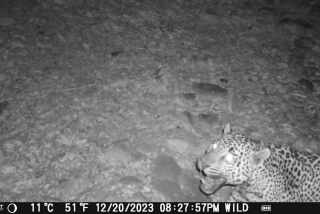U.S. Launches Costly Overhaul of Spy Satellites
- Share via
WASHINGTON — The Clinton Administration is spending billions of dollars to upgrade America’s secret spy satellites for the post-Cold War world, replacing systems originally designed to monitor Soviet military targets with satellites more useful in fast-moving regional conflicts, U.S. sources said.
Under one top-secret project, the United States is developing a new, highly flexible series of satellites, code-named 8X, that will provide the CIA and the Pentagon with vastly expanded photographic coverage, making the satellites more adaptable for use by military commanders faced with an array of potential battlefields around the world.
The 8X will be a major upgrade of the KH-12, the current spy satellite workhorse, sources said. The 8X, under development by Lockheed Martin Corp., which builds spy satellites in Sunnyvale, Calif., will be a behemoth, weighing as much as 20 tons, and will be capable of capturing intricately detailed images of areas as large as 1,000 square miles of the Earth’s surface.
Once they are in use--which could be between the years 1998 and 2000--the 8X satellites will be far larger and more capable than any such satellite system in history.
Experts estimated that the 8X modification program could cost as much as $1.5 billion, not including the cost of the $350-million Titan IV rocket needed to loft each satellite payload or the elaborate ground equipment required to process the data.
But the 8X is just one part of a multibillion-dollar post-Cold War update of America’s super-secret constellation of spy satellites, which perform such varied tasks as monitoring the Earth for an enemy missile launch, collecting foreign telephone conversations or capturing the electronic signals emitted by enemy weapons systems.
Overhaul of the nation’s fleet of spy satellites has come largely in response to complaints by then-Gen. H. Norman Schwarzkopf and other military leaders after the 1991 Persian Gulf War that the existing network could not provide adequate, timely intelligence for the fast-paced operations of a tactical war.
The current generation of photographic satellites take very high resolution images, but each photograph covers a relatively small area--roughly 10 miles by 10 miles according to John Pike, a space expert at the Federation of American Scientists. To patch together an image of an area as large as 1,000 square miles, a satellite had to repeatedly cross over the target, sometimes taking days.
That was fine for the Cold War, when military planners needed simply to periodically examine missile silos, submarine bases and other defense installations in the Soviet Union.
But those satellites had severe shortcomings in providing rapid updates during a battle. It took several days for military officials to get photographic updates for the complete Gulf War theater of operations, consisting of hundreds of thousands of square miles.
“It’s like looking at the world through a soda straw,” said one defense industry consultant of the existing spy satellites.
The 8X program would redress that shortcoming by covering roughly 800 to 1,000 square miles in each photograph, with roughly the same resolution as the existing satellites, Pike said. The current satellites can typically show details as small as about six inches, depending on the angle of the shot and the atmospheric conditions. Its supporters argue that 8X will give the Pentagon a revolutionary capability, allowing battlefield commanders to watch the entire scope of an enemy’s maneuvers over a very large area of battle.
“One of the biggest criticisms [of the intelligence community] during the Gulf War was the lack of broad-area [photographic] coverage--the military wanted to be able to look at all of Iraq at the same time,” said one source. “This is an attempt to deal with that concern for broader coverage by the military and to do it by modifying an existing system without having to develop an all-new satellite.”
Creation of the 8X was one of the recommendations made by a panel set up by former Director of Central Intelligence Robert M. Gates in 1992 to study the nation’s future spy satellite needs, sources said. Its development marks a turnaround in the fortunes of the spy satellite program.
Until only two years ago, the program appeared headed for major reductions as Congress made budget plans at the close of the Cold War. Congress, however, has voted only for modest cuts.
While the House Intelligence Committee has warned that “ever rising program costs no longer can be tolerated,” the CIA has not endured the sharp cutbacks made to the military services. The House has voted to cut just 1% from the spy satellite programs this year.
Development of the new satellites comes at a time when the secret agency that contracts for them, the National Reconnaissance Office, is under fire for hoarding more than $1 billion in unspent cash, and for maintaining a bloated budget.
Sources said the 8X program has also been the subject of a bitter budget fight between Congress and the intelligence community. It was a central issue in a long-running battle between former Senate Intelligence Committee Chairman Dennis DeConcini (D-Ariz.), who retired from the Senate last year, and former Director of Central Intelligence R. James Woolsey, who resigned last December.
Woolsey argued that by modifying the current generation of spy satellites into the 8X, the intelligence community could meet the military’s demands.
But DeConcini argued that the 8X was a waste of money, especially when there was a backlog of unused spy satellites in storage. Sources said, for example, that the United States now has as many as four KH-12 satellites going unused because earlier satellites have lasted longer than anticipated.
DeConcini wanted to continue to use the KH-12s until the nation could leapfrog to the next technology--advanced, radar-imaging satellites that could cut through darkness and cloud cover to provide photo-quality radar images. The United States currently has radar-imaging satellites, but new technology now under development will make those radar images much sharper.
While existence of the 8X program is top secret and the spending for it has been approved by Congress as part of the classified intelligence budget, an unusual insight into the program is contained in unclassified bidding documents for the Air Force’s new expendable launch vehicle, which specifies that the new launcher should be capable of putting a massive 45,000-pound payload into low Earth orbit, Pike said.
Other major spy satellite programs are under way as well. Lockheed Martin has also won a radar-imaging satellite contract, apparently for the Navy, while TRW Inc. and Hughes Aircraft Co., both in the South Bay, are working on updates of several “signals-intelligence” satellites, according to an industry official who asked not to be quoted by name. TRW is also the prime contractor for the Pentagon’s Brilliant Eyes early-warning satellite.
More to Read
Sign up for Essential California
The most important California stories and recommendations in your inbox every morning.
You may occasionally receive promotional content from the Los Angeles Times.











